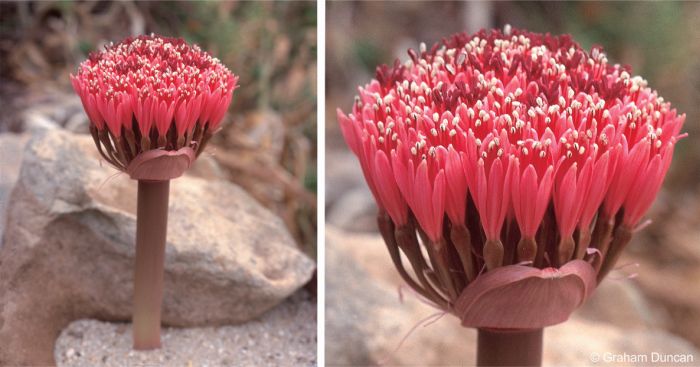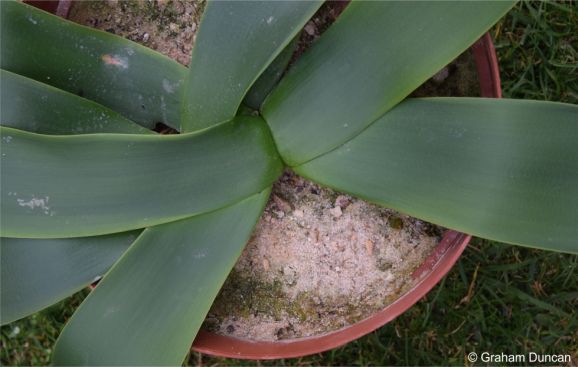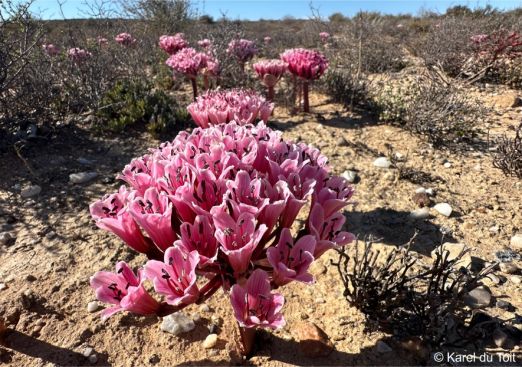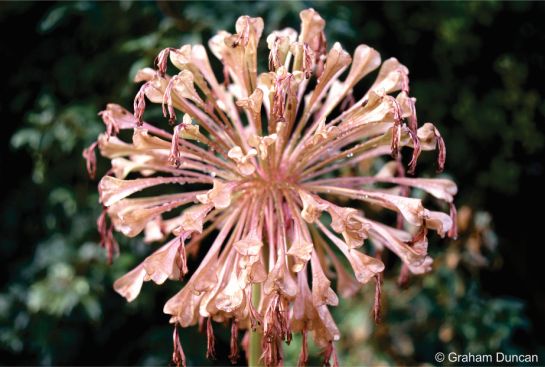Brunsvigia pulchra
Brunsvigia pulchra (W.F.Barker) D.Müll.-Doblies & U.Müll.-Doblies
Family: Amaryllidaceae
Common names: Namaqualand tulip, torch candelabra (Eng.)
Introduction
Brunsvigia pulchra is a rarer member of the genus, restricted to the more arid, semi-desert region of Namaqualand. There is a striking contrast between the unripe and ripe anthers, starting a deep maroon and maturing and ripening to cream.

Description
Description
Brunsvigia pulchra, is a deciduous, winter-growing geophyte, with a subterranean bulb. The bulb is ovoid (egg-shaped) and measures 70-90 mm in diameter, covered with dense, membranous, light to dark brown tunics. Flowers are produced before the leaves in autumn, from March to May. Standing 200 to 300 mm high when in full flower, individual flowers are light- to deep rose-pink and 45-55 mm in length. Flowers may last from 7 to 10 days, and the feature that differentiates this species from other brunsvigias is that all flowers stand straight up during flowering. They produce fleshy, brownish green seeds that are 5 mm in diameter. Brunsvigia pulchra produces 5-7 oval-shaped leaves after the first good winter rains. They are 250-450 mm long and 100-220 mm wide. The upper surface is dark green and velvety to the touch whereas the lower surface is light green and smooth.
Brunsvigia pulchra is remarkable among members of this genus of about 18 species in that its flowers are carried in a dense, conical or brush-like flower head that, from a distance, resembles a pink tulip. The flowers have erect, overlapping tepals and upright, straight stamens with maroon unripe anthers that turn cream-coloured when ripe. When in flower, the flower stalks (pedicels) are more or less erect, but they elongate considerably in fruit and form a rounded seed head that is indistinguishable from that of Brunsvigia bosmaniae. Similary, the leaves are difficult to distinguish from those of B. bosmaniae.

Conservation Status
Status
The current conservation status is considered as Rare but not threatened, according to the SANBI Red List of South African Plants. It is a Namaqualand endemic known from nine subpopulations and is restricted to elevated slopes.
Distribution and habitat
Distribution description
It occurs from southern Namaqualand to northern Namaqualand. Plants are exposed to full sun and occur on elevated flats and lower mountain slopes. Like most other Namaqualand Brunsvigia species, it grows in very well-drained soils, comprised of reddish-brown granitic or quartzitic soils. Plants occur in very arid habitats growing alongside low renosterveld scrub. Flowering takes place in autumn, from March to May, but can be erratic, andis greatly enhanced by good late summer and early autumn rains.

Derivation of name and historical aspects
History
The genus Brunsvigia was named in 1755 by the Dutch botanist Lorenz Heister in honour of the German Duke Karl Wilhelm Ferdinand of Braunschweig-Wolfenbüttel. The speces name pulchra, which means ‘beautiful’, refers to the deep rose-pink coloured flowers. Brunsvigia pulchra was collected initially by the South African botanist Winsome F. Barker in 1951, who first described it as Boophone pulchra in 1963. Due to its close morphological ties with Brunsvigia, it was moved to the latter genus in 1994 by D. and U. Müller-Doblies.

Ecology
Ecology
Brunsvigia pulchra flowers in autumn, produces leaves in late autumn and winter, and is dormant in summer. In late autumn or early winter, the stem (peduncle) of the seed head breaks off at its base, and the light, rounded seed head disperses its seeds by wind-tumbling, scattering the seeds over a wide area. The seeds germinate co-incidentally with autumn and winter rains, forming a bulb before the dry summer months begin. Pollinators of this species are likely to be insects, possibly night-flying moths.
Uses
Use
Brunsvigia pulchra has no medicinal or magical uses, but it is occasionally cultivated as a container plant by specialist bulb growers.

Growing Brunsvigia pulchra
Grow
As with most species in the genus, the most common method of propagation is by seed. As with many, if not all species in the genus, the bulbs don’t readily form offsets, and if they do, the frequency of this is so erratic that it is not a reliable way to propagate the species. Brunsvigia seed is fleshy and short-lived, thus does not undergo a dormancy period, but begin to germinate as soon as the seed ripens.
Sow seeds in deep trays with a very fast-draining, sandy soil mix. A recommended medium to germinate and grow these seeds successfully, is 2 parts coarse river sand or silica sand, 1 part fine gravel, and 1 part sieved, 6 mm composted bark. Press the seeds lightly into the soil, so that the top of the seed remains visible, as burying the seeds may cause them to rot. Water very well, keep the trays just moist, and don’t let them dry out completely. Germination should occur quickly, within about a week or 10 days.Heavy watering is recommended for mature bulbs once every two weeks. When leaves start to turn yellow, withhold water completely as the bulb will go into dormancy for its summer rest.
Leave seedling bulbs in trays for the first 2 years, thereafter they can be repotted into deep pots and fed with a weak solution of water-soluble fertilizer, every 2 weeks during the growing season. Plants are best suited to pots, as those planted out in gardens may rot due to summer irrigation.
References
- Du Toit, K. 2024. Observation of Brunsvigia pulchra in habitat. iNaturalist. Online. https://www.inaturalist.org/observations/207817642.
- Duncan, G. 2002. Brunsvigia pulchra – the spectacular Namaqualand tulip. Veld & Flora 88(2): 60–62.
- Duncan, G. 2010. Grow bulbs. Kirstenbosch Gardening Series. South African National Biodiversity Institute, Cape Town.
- Duncan, G., Jeppe, B. & Voigt, L. 2016. The Amaryllidaceae of southern Africa. Umdaus Press, Pretoria.
- Snijman, D. 2005. Brunsvigia Heist. (Amaryllidaceae). PlantZAfrica. Online. http://pza.sanbi.org/brunsvigia.
- Snijman, D.A. & Victor, J.E. 2004. Brunsvigia pulchra (W.F.Barker) D.Müll.-Doblies & U.Müll.-Doblies. National Assessment: Red List of South African Plants. Accessed on 2024/10/29.
Credits
Gianpaolo Gilardi
Botanical Society of South Africa – Kirstenbosch Branch
November 2024
Acknowledgements: the author thanks Graham Duncan and Karel du Toit for providing images.
Plant Attributes:
Plant Type: Bulb
SA Distribution: Northern Cape, Western Cape
Soil type: Sandy
Flowering season: Autumn
PH:
Flower colour: Pink
Aspect: Full Sun
Gardening skill: Average
Special Features:
Horticultural zones








Rate this article
Article well written and informative
Rate this plant
Is this an interesting plant?
Login to add your Comment
Back to topNot registered yet? Click here to register.